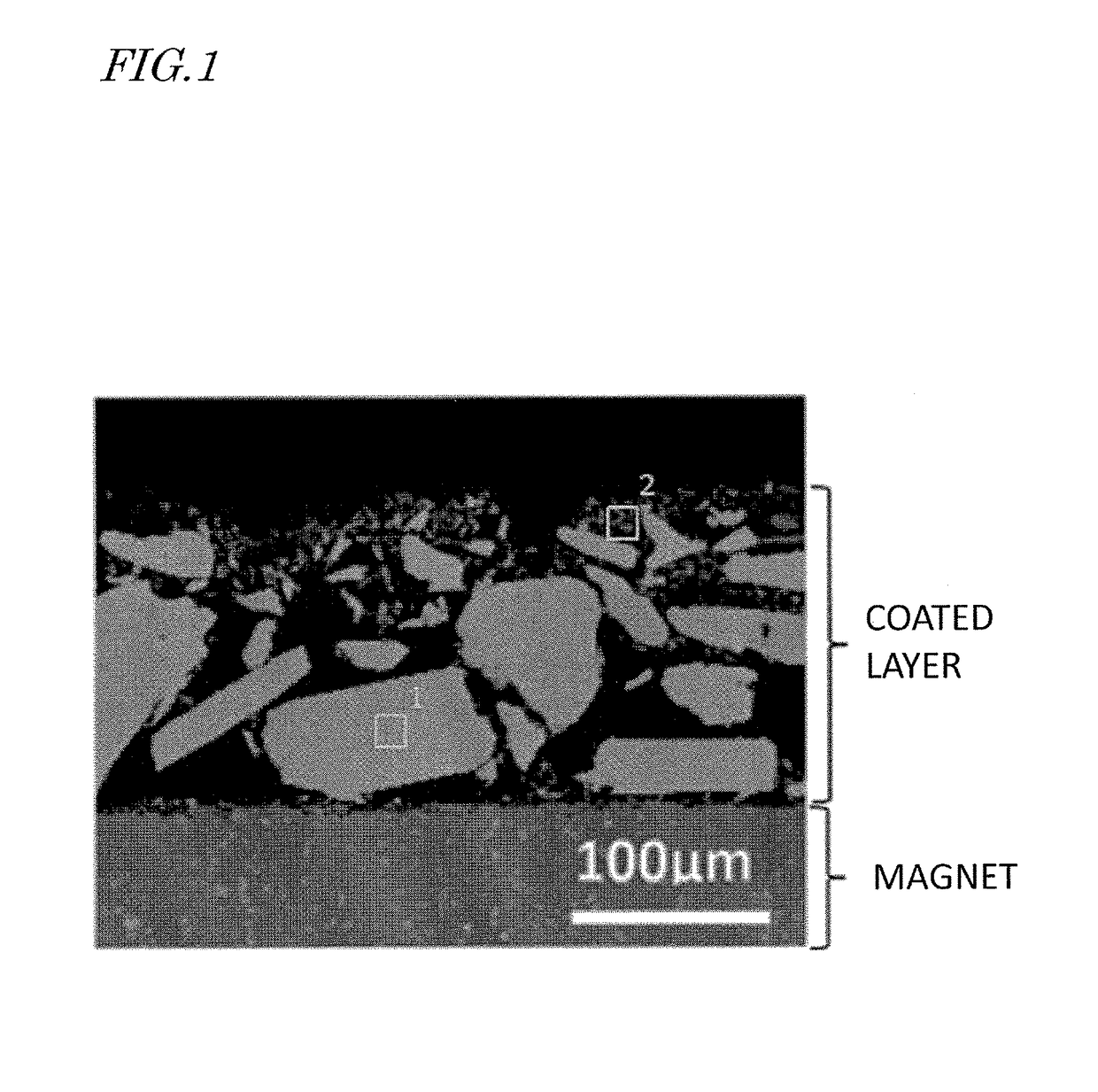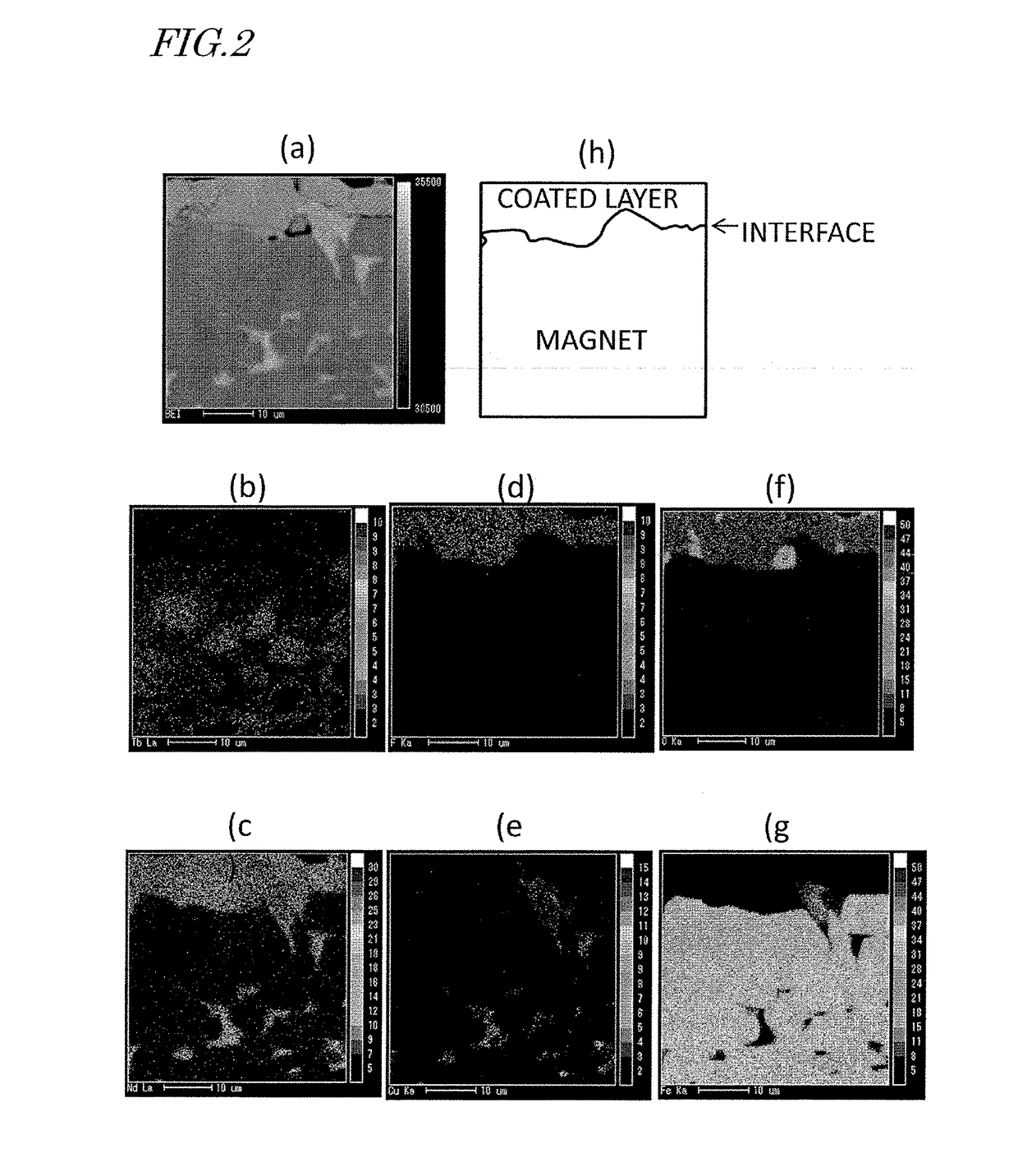Production method for r-t-b sintered magnet
- Summary
- Abstract
- Description
- Claims
- Application Information
AI Technical Summary
Benefits of technology
Problems solved by technology
Method used
Image
Examples
experimental example 1
[0057]First, by a known method, a sintered R-T-B based magnet with the following mole fractions was produced: Nd=13.4, B=5.8, Al=0.5, Cu=0.1, Co=1.1, balance=Fe (at %). By machining this, a sintered R-T-B based magnet matrix which was 6.9 mm×7.4 mm×7.4 mm was obtained. Magnetic characteristics of the resultant sintered R-T-B based magnet matrix were measured with a B-H tracer, which indicated an HcJ of 1035 kA / m and a Br of 1.45 T. As will be described later, magnetic characteristics of the sintered R-T-B based magnet having undergone the heat treatment are to be measured only after the surface of the sintered R-T-B based magnet is removed via machining. Accordingly, the sintered R-T-B based magnet matrix also had its surface removed via machining by 0.2 mm each, thus resulting in a 6.5 mm×7.0 mm×7.0 mm size, before the measurement was taken. The amounts of impurities in the sintered R-T-B based magnet matrix was separately measured with a gas analyzer, which showed oxygen to be 760...
experimental example 2
[0067]Sintered R-T-B based magnet matrices identical to those of Experimental Example 1 were provided. Next, diffusion auxiliary agents having compositions as shown in Table 4 and a TbF3 powder or a DyF3 powder having a particle size of 20 μm or less were provided, and each was mixed with a 5 mass % aqueous solution of polyvinyl alcohol, thus providing slurries of diffusion auxiliary agents and slurries of diffusion agents.
[0068]These slurries were applied onto two 7.4 mm×7.4 mm faces of the sintered R-T-B based magnet matrix, so that the mass ratio between the diffusion auxiliary agent and the diffusion agent and the RH amount per 1 mm2 of the surface of the sintered R-T-B based magnet (diffusion surface) had values as shown in Table 4. Specifically, the slurry of a diffusion auxiliary agent was applied to a 7.4 mm×7.4 mm upper face of the sintered R-T-B based magnet matrix, and after it was dried at 85° C. for 1 hour, the slurry of a diffusion agent was applied and similarly dried...
experimental example 3
[0071]Samples 15 to 22, 38, 39, 115 to 122, 138 and 139 were obtained in a similar manner to Experimental Example 1, except for using diffusion auxiliary agents having compositions as shown in Table 6 and using powder mixtures obtained through mixing with a TbF3 powder according to the mixed mass ratio shown in Table 6. Magnetic characteristics of Samples 15 to 22, 38, 39, 115 to 122, 138 and 139 thus obtained were measured with a B-H tracer, and variations in HcJ and Br were determined. The results are shown in Table 7.
TABLE 6diffusiondiffusionmixed mass ratioRH amountauxiliary agentagent(diffusion auxiliaryper 1 mm2Samplecompositionmeltingcompositionagent:diffusionof diffusionNo.(at. ratio)point (° C.)(at. ratio)agent)surface (mg)15Nd95Cu5930TbF38:20.07ComparativeExample16Nd85Cu15770TbF38:20.07Example17Nd50Cu50690TbF38:20.07Example18Nd27Cu73770TbF38:20.07ComparativeExample19Nd80Fe20690TbF38:20.07Example20Nd80Ga20650TbF38:20.07Example21Nd80Co20630TbF38:20.07Example22Nd80Ni20580TbF3...
PUM
| Property | Measurement | Unit |
|---|---|---|
| Area | aaaaa | aaaaa |
Abstract
Description
Claims
Application Information
 Login to View More
Login to View More - R&D
- Intellectual Property
- Life Sciences
- Materials
- Tech Scout
- Unparalleled Data Quality
- Higher Quality Content
- 60% Fewer Hallucinations
Browse by: Latest US Patents, China's latest patents, Technical Efficacy Thesaurus, Application Domain, Technology Topic, Popular Technical Reports.
© 2025 PatSnap. All rights reserved.Legal|Privacy policy|Modern Slavery Act Transparency Statement|Sitemap|About US| Contact US: help@patsnap.com



